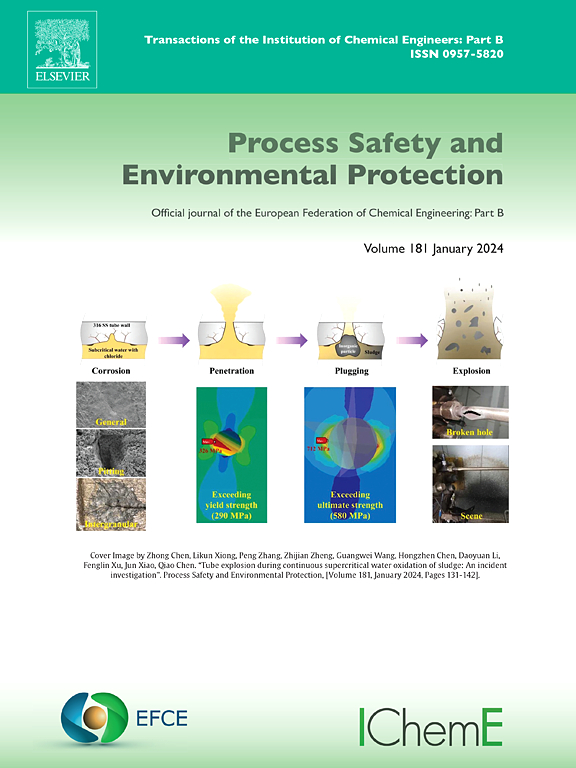Simultaneous removal of Cr(VI), Cd(II) and As(III) in groundwater by ZVI-biochar based composite: Synergy, performance and mechanism
IF 6.9
2区 环境科学与生态学
Q1 ENGINEERING, CHEMICAL
引用次数: 0
Abstract
The efficient remediation of multi-heavy metals contaminated groundwater by permeable reactive barrier (PRB) is a global concern due to its importance for human health and ecosystems. However, the development of PRB materials that are high efficiency, low cost and environmentally friendly is still limited. In this paper, a novel composite material consisting of ZVI/biochar/scoria was developed for simultaneous removal of Cr(VI), Cd(II) and As(III) from groundwater, and the batch and column experiments were conducted to assess the synergistic effect, removal efficiency, adsorption mechanism of the composite material. The results showed that when the optimum ratio of ZVI/biochar/scoria was 4:2:1, the simultaneous removal rate of Cr(VI), Cd(II), and As(III) reached 99.25 %, 98.97 % and 95.18 %, respectively. The adsorption of heavy metal ions by ZVI-biochar based composite displayed competitive and selective behaviour in a descending order of Cd(II)>Cr(VI)>As(III). After 44 days of continuous operation, the column adsorption experiments achieved a removal rate of 99.95 %, 90.76 % and 86.72 % for Cr(VI), Cd(Ⅱ) and As(Ⅲ). The composite material exhibited broad pH adaptability (pH 5–9) and resistance to common ions (Cl⁻, SO₄²⁻, Fe3 +, Mn2+, Na+ and K+), though HCO₃⁻ significantly inhibited Cr/As removal. The characterization results revealed that the removal mechanisms of the composite for three heavy metals were dominated by reduction and precipitation (Cr(VI)), electrostatic attraction and surface complexation (Cd(II)), and oxidation and co-precipitation (As(III)), respectively. The simultaneous removal of Cr(VI), Cd(II) and As(III) was significantly enhanced by the synergistic effect of Fe-C microelectrolysis, biochar functional groups and scoria adsorption.
zvi -生物炭复合材料同时去除地下水中Cr(VI)、Cd(II)和As(III):协同作用、性能及机理
由于渗透反应屏障对人类健康和生态系统的重要性,其对多重金属污染地下水的有效修复一直是全球关注的问题。然而,高效、低成本、环保的PRB材料的开发仍然有限。采用ZVI/生物炭/炉渣复合材料同时去除地下水中的Cr(VI)、Cd(II)和As(III),并进行了批式和柱式实验,考察了复合材料的协同效应、去除效率和吸附机理。结果表明,当ZVI/生物炭/炉渣的最佳配比为4:2:1时,Cr(VI)、Cd(II)和As(III)的同时去除率分别达到99.25 %、98.97 %和95.18 %。zvi -生物炭基复合材料对重金属离子的吸附表现出从Cd(II)→gt→Cr(VI)→gt→As(III)的竞争和选择行为。连续运行44 d后,柱吸附实验对Cr(VI)、Cd(Ⅱ)和As(Ⅲ)的去除率分别为99.95 %、90.76 %和86.72 %。这种复合材料表现出广泛的pH适应性(pH 5-9)和对常见离子(Cl -, SO₄²⁻,Fe3 +,Mn2+, Na+和K+)的抗性,尽管HCO₃会显著抑制Cr/As的去除。表征结果表明,复合材料对三种重金属的去除机制分别以还原沉淀(Cr(VI))、静电吸引和表面络合(Cd(II))和氧化共沉淀(As(III))为主。Fe-C微电解、生物炭官能团和炉渣吸附的协同作用显著增强了Cr(VI)、Cd(II)和As(III)的同时去除效果。
本文章由计算机程序翻译,如有差异,请以英文原文为准。
求助全文
约1分钟内获得全文
求助全文
来源期刊

Process Safety and Environmental Protection
环境科学-工程:化工
CiteScore
11.40
自引率
15.40%
发文量
929
审稿时长
8.0 months
期刊介绍:
The Process Safety and Environmental Protection (PSEP) journal is a leading international publication that focuses on the publication of high-quality, original research papers in the field of engineering, specifically those related to the safety of industrial processes and environmental protection. The journal encourages submissions that present new developments in safety and environmental aspects, particularly those that show how research findings can be applied in process engineering design and practice.
PSEP is particularly interested in research that brings fresh perspectives to established engineering principles, identifies unsolved problems, or suggests directions for future research. The journal also values contributions that push the boundaries of traditional engineering and welcomes multidisciplinary papers.
PSEP's articles are abstracted and indexed by a range of databases and services, which helps to ensure that the journal's research is accessible and recognized in the academic and professional communities. These databases include ANTE, Chemical Abstracts, Chemical Hazards in Industry, Current Contents, Elsevier Engineering Information database, Pascal Francis, Web of Science, Scopus, Engineering Information Database EnCompass LIT (Elsevier), and INSPEC. This wide coverage facilitates the dissemination of the journal's content to a global audience interested in process safety and environmental engineering.
 求助内容:
求助内容: 应助结果提醒方式:
应助结果提醒方式:


